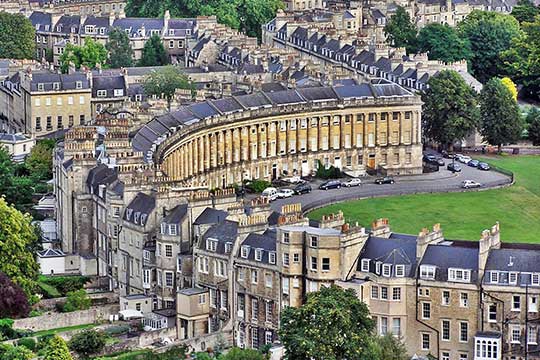I am cruising through The Architecture of Happiness, wishing I had the time and energy to quote and then rebut its every line. Alain de Botton’s book is a masterpiece, but I have been forced to conclude that it is a masterpiece of dishonesty. Consider the following passage, from a chapter called “On the Virtues of Buildings”:
We might expect that it would, by now, have grown as easy to reproduce a city with the appeal of Bath as it is to manufacture consistent quantities of blueberry jam. If humans were at some point adept at creating a masterwork of urban design, it should come within the grasp of all succeeding generations to contrive an equally successful environment at will. There ought to be no need to pay homage to a city as to a rare creature; its virtues should be readily fitted to the development of any new piece of meadow or scrubland. There should be no need to focus our energies on preservation and restoration, disciplines which thrive on our fears of our own ineptitude. We should not have to feel alarmed by the waters that lap threateningly against Venice’s shoreline. We should have the confidence to surrender the aristocratic palaces to the sea, knowing that we could at any point create new edifices that would rival the old stones in beauty.
Has de Botton not noticed that sometime in the middle of the last century dominance of the fields involved in building cities was achieved by modern architecture and planning? Has he forgotten that, instead of a choice of modern and traditional work, national and city development authorities have sought to delegitimize and even to ban traditional buildings and patterns of urban design? Does he not realize that the movements of preservation and, later, new urbanism arose from “our fears of our own ineptitude” – or, rather, our fear of the will to ugliness that for years now has characterized architecture and planning?
I think de Botton knows all of this very well. His purported confusion is a species of fraud, of rank dishonesty. “In frustration,” he writes, “[architects] have turned against the very idea of laws [of civic beauty], declaring them naive and absurd, symptoms of utopian and rigid minds.” “In frustration”!? Does he not mean “In triumph”? Yet in the long passage above he admits that “at some point humans were adept at creating a masterwork of urban design.” He goes on to argue that a dictionary of building virtues is needed to revive our talent for building beautiful cities, and then pooh-poohs the idea.
“In frustration” is the locution he uses above to purport a sort of sadness among architects that they have lost the ability to create beautiful cities, when in fact, as de Botton knows very very well, it was not lost but banned. Preventing the construction of beauty in cities and working to destroy what was built before are major initiatives in architecture’s top organizations, the American Institute of Architects and the schools of architecture.
De Botton’s rhetorical switcheroo is dishonesty pure and simple, but he is so, so good at it that even I marvel at the sophistication of his prose, and his sly ability to subvert the obvious implication of almost everything he writes. A reader commenting on my last post quoting de Botton tarred him with the word “clever.” The word carries a hint of the idea of seedy manipulation. It is the perfect word to describe him.




de Botton’s book is an apology for Modernism. I lost patience with it early on, but read it to the end because it was infuriating enough to keep me going.
LikeLike
St. Mary’s has a crescent of townhouses like this (but not as pretty) that partially encircled an athletic field and looked out on more housing. It was just as party central as the Quad!
A
___ Aaron W. Brussat *Beer Steward* *The Bier Stein Bottleshop & Pub* *&* *Willamette Valley Columnist* *Northwest Brewing News*
*@beer_stone*
LikeLike
It is one of my great regrets that I never made it down to St. Mary’s while you were there. Maybe we can all go someday. When I was at Mizzou, I recall that the main quad was graced by a line of six Ionic columns, representing (campus humor alert!) the six surviving virgins on campus. It was a center of beers, joints, carousing and quite lovely.
LikeLike
Nobody stops to think that it’s not up to architects or civic planners. Great cities arise from great cultures–lively, vibrant cultures operating on a specific set of shared values. Without that, how on Earth do you think that any accomplishment can be achieved!
LikeLike
Granted, but what’s your point? That architects and planners are not involved? Obviously that’s not the case. That no great, lively, vibrant cultures exist to generate great cities? That may be an arguable proposition, but you’ll get lots of pushback from most people everywhere. Rather, it is clear that culture’s expression in great architecture and urbanism is made more difficult by currently dominant architectural and planning practices.
LikeLike
Anonymous, why is it that architects and planners much more likely to leave anonymous comments than in most online discussions on other topics? And what are you saying isn’t up to architects or civic planners? The culture of Bath just popped out a crescent or two? John Wood had nothing to do with it? Yes, Wood was largely a product of his culture, but unlike vernacular construction that really was produced by the townspeople, most of the architecture of Bath could not have existed without highly competent people like Wood.
LikeLike